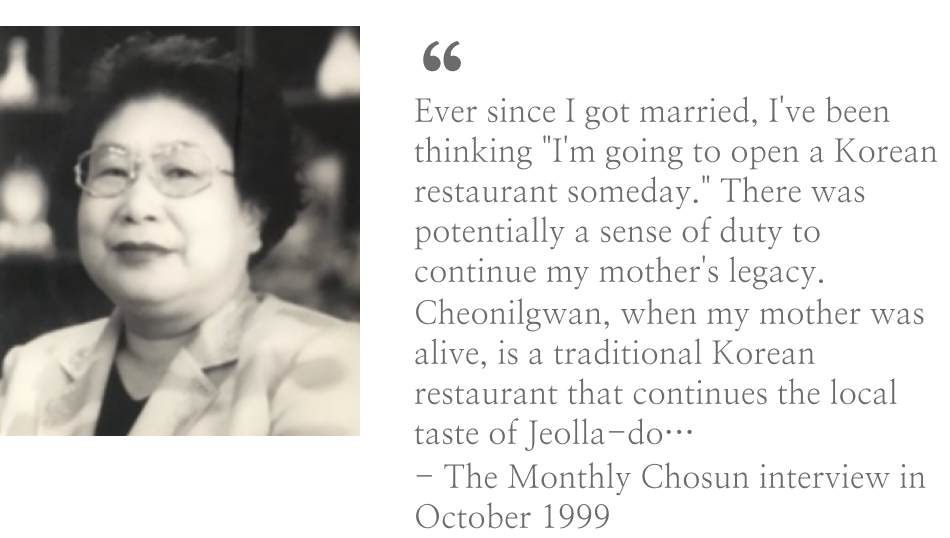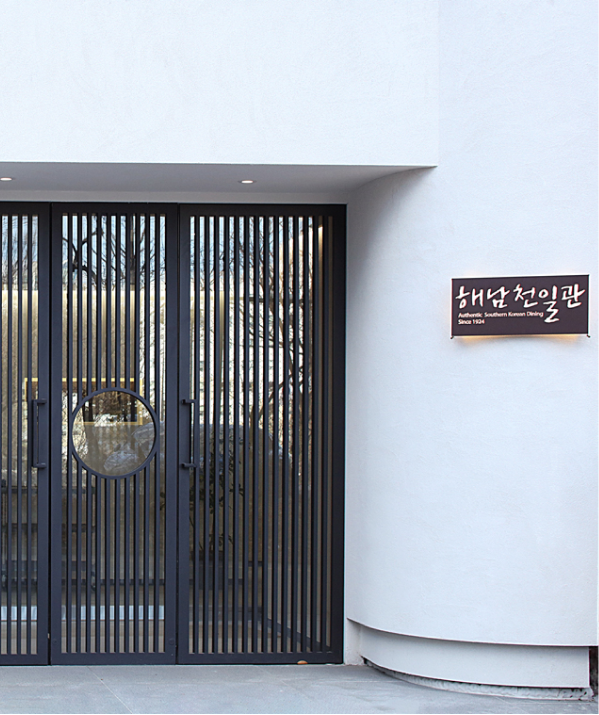Haenam Cheonilgwan has been serving a variety of menus in the traditional way for 100 years.
Customers can enjoy fresh ingredients from nature and carefully cooked food.
Throughout the future, Haenam Cheonilgwan will always serve customers with the best service and satisfying food.

1924 – Mrs. Park Sung-soon, the founder, opens “Cheonilgwan”
In 1924, the founder, Park Sung-soon (passed away in 1973), opened Cheonilgwan at the current location in Haenam, starting from a stall at the 5-day market in Yunnae-ri, Haenam-eup. Mrs.Park always used good ingredients and put her heart into her food, firmly believing that food comes from home, natural products, and the land in season are best for the body.

Since 1970 – 3 generations of tradition in Haenam
When the restaurant was founded in 1924, the name was “Cheonilgwan.” The late Lee Jung-ye, the second daughter-in-law to take over the restaurant, changed the name to “Cheonil Sikdang,” and now the third generation, Oh Hyun-hwa, the grandson and daughter-in-law, is carrying on the tradition. Over the years, Cheonil Sikdang has become a well-known Haenam attraction, not because of the number of side dishes, but because of the legendary handiwork of the founder, Park Sung-soon, and the consistent efforts of the family members who have carried on the tradition for three generations.

1990 – Mrs. Jung Sim Kim, 2nd CEO – revived Cheonilgwan in Seoul.
The 2nd CEO and the youngest daughter of the founder, Mrs. Kim Jeong Shim (passed away in 2015), revived Haenam Cheonilgwan in 1990 in Samseong-dong, Seoul. The reopened Cheonilgwan’s kitchen were taken over by the founders longtime colleagues from Haenam, helping to keep the unique flavors and traditions of Southern Korean cuisine alive.

HwaYoung Lee, the 3rd CEO – Capturing elegance
Inheriting the flavors of the founder and the 2nd CEO, Mrs. Hwa Young Lee settled down in Yeoksam-dong with the idea of putting on sophisticated “clothes”, i.e. plating, that match the flavors of Southern Korean food. For example, Mrs. Lee collaborated with Korean ceramic artist Heon-jin Jung to create bowls that showcase the sincerity of Southern Korean food culture.


1924 – Mrs. Park Sung-soon, the founder, opens “Cheonilgwan”
In 1924, the founder, Park Sung-soon (passed away in 1973), opened Cheonilgwan at the current location in Haenam, starting from a stall at the 5-day market in Yunnae-ri, Haenam-eup. Mrs.Park always used good ingredients and put her heart into her food, firmly believing that food comes from home, natural products, and the land in season are best for the body.

Since 1970 – 3 generations of tradition in Haenam
When the restaurant was founded in 1924, the name was “Cheonilgwan.” The late Lee Jung-ye, the second daughter-in-law to take over the restaurant, changed the name to “Cheonil Sikdang,” and now the third generation, Oh Hyun-hwa, the grandson and daughter-in-law, is carrying on the tradition. Over the years, Cheonil Sikdang has become a well-known Haenam attraction, not because of the number of side dishes, but because of the legendary handiwork of the founder, Park Sung-soon, and the consistent efforts of the family members who have carried on the tradition for three generations.

1990 – Mrs. Jung Sim Kim, 2nd CEO – revived Cheonilgwan in Seoul.
The 2nd CEO and the youngest daughter of the founder, Mrs. Kim Jeong Shim (passed away in 2015), revived Haenam Cheonilgwan in 1990 in Samseong-dong, Seoul. The reopened Cheonilgwan’s kitchen were taken over by the founders longtime colleagues from Haenam, helping to keep the unique flavors and traditions of Southern Korean cuisine alive.

2013 – HwaYoung Lee, the 3rd CEO Capturing elegance
Inheriting the flavors of the founder and the 2nd CEO, Mrs. Hwa Young Lee settled down in Yeoksam-dong with the idea of putting on sophisticated “clothes”, i.e. plating, that match the flavors of Southern Korean food. For example, Mrs. Lee collaborated with Korean ceramic artist Heon-jin Jung to create bowls that showcase the sincerity of Southern Korean food culture.



Celebrating 100th anniversary
The food at Haenam Cheonilgwan inherits the flavors and traditions of the past 100 years, using seasonal ingredients and carefully selecting each seasoning. Unlike the outward appearance of a fancy table, each dish is prepared with great care and honesty. The restaurant strives to continue the culture of traditional Korean food with flavor and unwavering sincerity.
Haenam Cheonilgwan moved to its current location in Seorae maul, Banpo-dong, in 2022, continuing its century-long history. This history is not only our pride but also our responsibility.


Celebrating 100th anniversary
The food at Haenam Cheonilgwan inherits the flavors and traditions of the past 100 years, using seasonal ingredients and carefully selecting each seasoning. Unlike the outward appearance of a fancy table, each dish is prepared with great care and honesty. The restaurant strives to continue the culture of traditional Korean food with flavor and unwavering sincerity.
Haenam Cheonilgwan moved to its current location in Seorae maul, Banpo-dong, in 2022, continuing its century-long history. This history is not only our pride but also our responsibility.
At Haenam Cheonilgwan, food is served on JUNGDAM porcelain by artist Hyunjin Jung.

The ceramics are used as tableware at Haenam Cheonilgwan. JUNGDAM, which means ‘people who hold sincerity’, is handmade by artist Hyunjin Jung, and has the meaning of ‘sharing and rest’, especially with the three dots in the inlaid pattern. It is said that when our ancestors sowed seeds in the past, they put three seeds in one hole, hoping that one would be eaten by the earth, one by the sky, and the last one by humans. Based on this generous and giving aesthetic, we serve carefully prepared food on ceramics made with the hope that our hearts and eyes will feel the same way.
At Haenam Cheonilgwan, food is served on JUNGDAM porcelain by artist Hyunjin Jung.

The ceramics are used as tableware at Haenam Cheonilgwan. JUNGDAM, which means ‘people who hold sincerity’, is handmade by artist Hyunjin Jung, and has the meaning of ‘sharing and rest’, especially with the three dots in the inlaid pattern. It is said that when our ancestors sowed seeds in the past, they put three seeds in one hole, hoping that one would be eaten by the earth, one by the sky, and the last one by humans. Based on this generous and giving aesthetic, we serve carefully prepared food on ceramics made with the hope that our hearts and eyes will feel the same way.
All rights reserved@ 2023 Haenam Cheonilgwan
All rights reserved@ 2023 Haenam Cheonilgwan